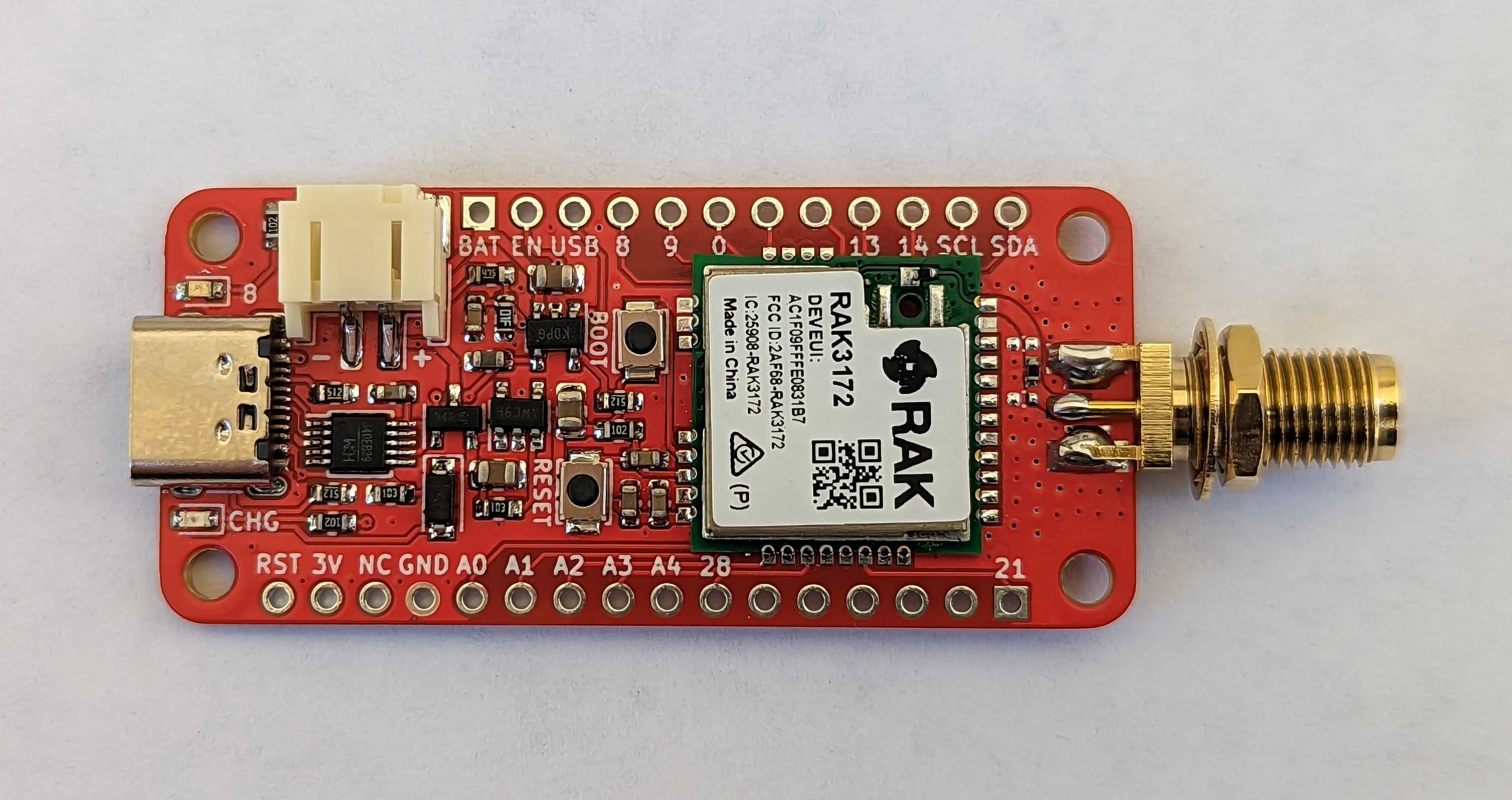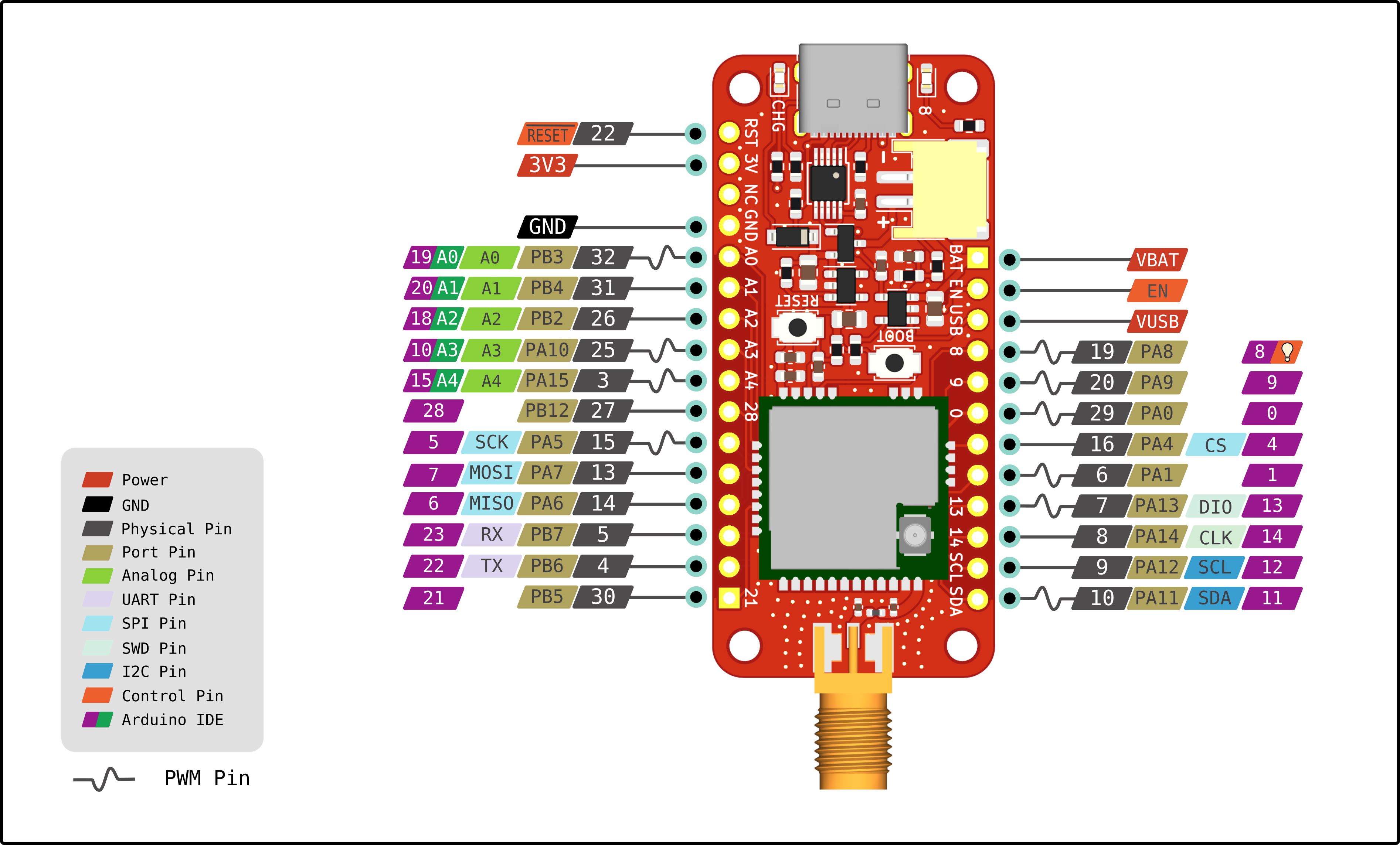Teapotlabs Feather RAK3172 a Low-cost, Low-power LoRaWAN development board that breaks out RAKwireless RAK3172 to an Adafruit Feather-compatible format.
Based on the RAK3172, a STM32WLE5CC based module with ARM Cortex M4 processor, 48 MHz and 3.3V logic. The chip has a 256K of flash and 64K of RAM. With low-power application in mind, the board is capable to be in sleep mode for as low as 11uA, it also has a built-in voltage divider to sense battery voltage and battery charger.
Teapotlabs Feather RAK3172 is heavily inspired by Penguino STM32WL LoRa-E5 and BastWAN-WLE projects!
- RAK3172: An STM32WLE5CC module
- 3.3V only power/pin.
- Down to 11uA Deep-Sleep
- Switchable TX Power. 14 dBm or 22 dBm on 915MHz frequency
- Supports LoRaWAN 1.0.3
- USB-C for Arduino and Mbed OS/STM32Cube programming
- SMA antenna connector
- JST-PH 2-Pin Battery Connector
- Built-in LiPo Charger ( 200mA Charge Rate )
- Voltage-Divider for Battery Monitoring ( default: disabled )
- LED Indicator on pin 8 ( default: disabled )
- Compatible with many Adafruit FeatherWings
- Max 1A power output
- Update assembly/TeapotFeatherRAK3172_Assembly.zip and docs file to Revision 9.1
- JP1 and JP4: Enable/Disable Voltage Divider for Battery Sensing
- JP2: Enable/Disable LED Indicator on Pin 8
- JP3, JP5, and JP6: Enable/Disable UART Bridge
- Revision 9 : First public release
- Revision 9.1: Fix LED D1 polarity
⚠️ The following pinout is not complete, please see STM32WLE5CC datasheet for more details.
Built using KiCAD, the board is design to be as small as possible. The following design are based on the latest revision.
| Top Board | Bottom Board |
|---|---|
The case is design by atmakers with Attribution-ShareAlike 3.0 Unported (CC BY-SA 3.0) license. The cases are 3D printable with any generic 3D printer with/without suppport (depends on the orientation). The STL files are available from authors download page here or from this repo.
Power consumption measured using Nordic PPK2. The following are the summary of the measurement:
- Sleep and all jumper disabled (JP1 - JP6): 10.44 uA
- Sleep and UART-Bridge enabled ( JP3, JP5, and JP6 ): 23.76 uA
- Sleep, UART-Bridge and Battery Sense enabled ( JP1, and JP3 - JP6 ): 25.41 uA
- Transmit at 14 dBm: 40.45 mA
- Transmit at 20 dBm: 100.38 mA
More detailed measurement can be found here
Most of the components are generic and can be bought from any electornics/semi-conductor distributor. RAK3172 is the only component available in RAKwireless store. The bill of materials can be downloaded here
⚠️ Be sure to buy the RAK3172 variant without IPEX to use SMA connector
| Id | Designator | Quantity | Value | Footprint |
|---|---|---|---|---|
| 1 | C11,C7,C4,C1 | 4 | 100n | 0603_1608Metric |
| 2 | C6,C3 | 2 | 10u | 0603_1608Metric |
| 3 | C9,C8,C10 | 3 | 10u | 0805_2012Metric |
| 4 | D1 | 1 | BLUE | 0603_1608Metric |
| 5 | D2 | 1 | ORANGE | 0603_1608Metric |
| 6 | D3 | 1 | B5819W | SOD-123 |
| 7 | J3 | 1 | U262-161N-4BVC11 | USB_C_Receptacle_XKB_U262-16XN-4BVC11 |
| 8 | J4 | 1 | SMA-KE-P903 | SMA-KE-P903 |
| 9 | J6 | 1 | S2B-PH-SM4-TB | JST_PH_S2B-PH-SM4-TB_1x02-1MP_P2.00mm_Horizontal |
| 10 | L1 | 1 | 0 | 0402_1005Metric |
| 11 | Q1 | 1 | DMG3415UQ-7 | SOT-23 |
| 12 | R10 | 1 | 10M | 0603_1608Metric |
| 13 | R2,R6,R1 | 3 | 1k | 0603_1608Metric |
| 14 | R3,R5,R4 | 3 | 5.1k | 0603_1608Metric |
| 15 | R7,R8 | 2 | 10k | 0603_1608Metric |
| 16 | R9 | 1 | 4.7M | 0603_1608Metric |
| 17 | SW1 | 1 | B3U-1000P | SW_SPST_B3U-1000P |
| 18 | SW2 | 1 | B3U-1000P | SW_SPST_B3U-1000P |
| 19 | U1 | 1 | RAK3172 | RAK3172 |
| 20 | U2 | 1 | CH340E | MSOP-10_3x3mm_P0.5mm |
| 21 | U3 | 1 | MCP73831T-2ACI/OT | SOT-23-5 |
| 22 | U4 | 1 | XC6220B331MR-G | SOT-23-5 |
| 23 | C5,C2 | 2 | DNP | 0402_1005Metric |
| 24 | J2 | 1 | DNP | PinHeader_1x12_P2.54mm_Vertical |
| 25 | J1 | 1 | DNP | PinHeader_1x16_P2.54mm_Vertical |
By default, programming the device can be done over the USB-C. Internally, the USB-C connects to the UART-Bridge that connects to the UART2 port of the RAK3172. Out of the factory, the RAK3172 chip ships with an AT firmware that can be tested by sending AT command via the USB-C.
Using the USB-C, user can program the board using the Arduino or MbedOS/STM32Cube SDK. The following are some very good tutorial to start developing with the device:
- Communicating with the AT firmware
- Programming with Arduino
- Programming with STM32Cube
- RAKDAP1 is not needed. Before connecting to STM32CubeProgrammer, hold
BOOTand pressRESETon the board, to boot to UART bootloader of the RAK3172. AfterRESETbutton is pressed,BOOTbutton can be released, and the board should be able to connect to the STM32CubeProgrammer
- RAKDAP1 is not needed. Before connecting to STM32CubeProgrammer, hold
- Programming with MbedOS
- Programming the board can be done without using the ST-LINK, it should be simillar to Programming with STM32Cube process.
Teapotlabs Feather RAK3172 is a feather compatible board, and hence is compatible with the many available FeatherWing. The following are some example project that uses FeatherWings.
An over-engineered clock with main purpose to showcase FeatherWings compatibility. FeatherWings and sensors used:
The project won't be possible without the amazing work from people across the globe. The following are the reference to those awesome projects:
The product is open-source! However, some part of library used under src, might have it's own license. Please reach out or create a ticket to report any license violation.














